Skin Deep(er)
Framing Statement
A performative piece of art with five performers that explores identity under the constraints of social conventions, by forming their own appearance and having it altered by the other bodies, exploring the way in which the site manipulates and influences people’s perceptions of identity.
Our performance, Skin Deep(er), is a deeply personal piece of performance art. We drew our initial inspiration from Marina Abramovic’s piece Rhythm 0, we wanted to explore the way in which Abramovic captured her audience simply by remaining still and focused for considerable periods of time. It was decided almost immediately that the main focus of our piece would be identity in art, as we were a group of 5 very diverse people with different body types, sexualities and backgrounds. We wanted to challenge the audience’s perceptions of what makes the human body art, while also trying to instill the idea that art is more than just what we see, it is about the artist who creates it. We noticed the majority of the nude paintings and sculptures around the Usher Gallery were of men and women with ‘perfect’ bodies. The men tended to be sculpted Adonises, with well-defined abdominal muscles and well-built arms and chests, and the women were voluptuous beauties with curves in all the right places and gravity defying breasts. We, as a group, felt that these images focused too much on aesthetic satisfaction and did not reflect what it is to be human and more importantly to have an identity. This lead us to a decision to begin our piece in just underwear, as it would give us an opportunity to illustrate that every human body is art, not just those that adhere to the typical standards of beauty or ‘perfection’.
We also took influence from Brett Bailey’s Exhibit B, which presented different kinds of native African bodies and their cultures within enclosures that aimed to reflect their typical environment. We decided to present our personas and identities in a similar ‘Human Zoo’ style. Our piece however was created of a much smaller, more intimate scale, the personas we exhibited were personal to us, they were a reflection of our true identities, rather than an entire culture to which we did not belong. We communicated this through the close and accessories we adorned ourselves with, the possessions we surrounded ourselves with and the confessions written on the cards, to be handed out to spectators if they came close enough to us to share our secrets.
Understanding Site-Specific Performance
Initial Inspirations
Having had our first site specific session yesterday I am feeling rather inspired. We have had an opportunity to explore the space (the collection) and the possibilities and inspirations it has to offer. Although the exhibition and collections we saw were very interesting and inspiring, I personally was more interested by the talk given by Ash at the beginning of the session. He spoke about the relevance and power of museums, and their political and historical importance. Museums define who we are and keep our history alive. They preserve a huge deal of our identity and our roots. “The value of museums for society can be expressed through five key factors: the value of collections, the educational value, the experience value, the social value and the economic value.” (Weide, 2011)
However we can also question whether they do this truthfully, as we know history can be bias and is often “written by the victors” (James, 1974). This leads us to think of museums in a philosophical sense and can create some very moral arguments. This was a lot for me to process, but I see this as a very positive thing. It has given me a great deal of inspiration and ideas that could be very useful in the creation of a piece of original performance art. The only issue I can see right now with using this as content would be the reflection on the collection. As they are being kind enough to let us use the space, I would not want to create any kind of negative implication toward the venue or the line of work itself.
Who’s Art? Who’s History?
I have spent the last week preparing my one minute piece in response to something in the gallery. Initially I was inspired by the image of the rings in the Viewpoints exhibition; the sense of personal emotion in the image was overwhelming. I realized that art is often only as real as the emotion of the artist. I felt in order to create my own piece of work that conveyed emotion I ought to find inspiration in something that felt more personal. Upon further investigation in the gallery i came across some broaches in a cabinet, which provoked the idea that jewelry (such as the broaches) is both art and history. Most jewelry has a personal story to tell and some may occasionally end up in galleries like The Collection.
I began to think about jewelry of emotional significance in my family, immediately my grandmother’s locket came to mind. As a child i would sit beside her and she would tell me about my great grandfather, who’s picture she kept in the locket. I decided my minute piece would be a retelling of one of these stories, as an account of my family’s history. I believe this fits with my current understanding of site specific performance; “performance specifically generated from […] selected layers of the site […]: historical documentation, site usage (past and present), found text, objects, actions, sounds, etc, anecdotal guidance, personal association,” (Wrights and Sights, 2001).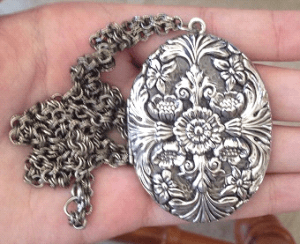
I feel that the collection setting combined with the personal association it inspired exposed the element of realism in my piece, which might otherwise have been overlooked. I began to feel that even though my story was personal, it was no less important than any other piece of art or history on display in The Collection. This task has helped me to further my understanding of site specific performance, I have come to realise that inspiration can be drawn from the site, but one might add their own element of personal inspiration to create something that reflects both the site and the artist.
Connecting With Site
I feel that after today’s session I have finally connected with the module. The session began in The Collection with a group discussion about what performance does. We concluded that performance engages the spectator’s senses, provokes contemplation and questioning. Performance inspires debates and restores a sense of community, which is why in many ways it can become the root of collective consciousness. In terms of site specific performance, it can bring new importance or purpose to the site. “The insertion of a classical or modern text in this found space throws new light on it, gives it an unsuspected power and places the audience at an entirely different relationship to the text, the place and the purpose for being there.” (Pearson, 2010)
I now understand how lucky we are to be performing in a museum and gallery, because as a site it holds a great deal of cultural importance in its role of educating people on our past and its connection to the world of Art. “In Wrights and [Sights]’ approach to the site, the site is of central importance and is a focal inspiration from which to devise the piece.” (Gleave, 2011) Given that my current understanding of what makes a performance Site-Specific, is that the performance is directly drawing influence and inspiration from its location, I couldn’t be happier with our site. I am still not sure that my understanding of Site-Specific performance is totally accurate, but I certainly feel more confident in it.
The Creation Process
(Image credit: © 2010 Scott Rudd www.scottruddphotography.com )
In an afternoon session we watched The Artist Is Present, a Documentary about Marina Abramovic’s work in the Museum of Modern Art. It was a collection of documentation and several re-performances. Having already researched Rhythm 0, I was aware that Marina was a highly dedicated and experimental performer. However upon watching “the artist is present” it became clear that marina was incredibly expressive and gave her whole self to ever performance. “Exploring the physical and mental limits of her being, she has withstood pain, exhaustion, and danger in the quest for emotional and spiritual transformation.” (Show of Force LLC and Mudpuppy Films Inc.) She inspired several performance artists, site-specific performances and has become a huge personal inspiration for me. The bravery and depth of her performances struck a chord with me and my group. We have already discussed the idea of doing an endurance piece related to identity and culture, however having watched Abromovic’s work we have found ourselves wanting to create a piece of self-reflective work, as it seems this can often create the most powerful performances.
Pitch Preparations
![IMAG0460[1]](https://sitespecific2015awa.blogs.lincoln.ac.uk/files/2015/04/IMAG04601-300x169.jpg) The current basis of our piece is five bodies presented in the gallery, each with a selection of different aesthetics. It will be a duration performance, with sets of two or three performers taking 20-30 minutes shifts at any one time. Our idea is to essentially become an exhibit which will reflect the way in which gallery visitors view ‘beauty’ and art in relation to identity. The concept means that our piece can only be truly understood when performed in the Gallery, as it is a direct response. This stemmed from Pearson and Shanks’ idea that site-specific performances should be “inseparable from their sites, the only contexts within which they are intelligible” (Pearson and Shanks. 2001)
The current basis of our piece is five bodies presented in the gallery, each with a selection of different aesthetics. It will be a duration performance, with sets of two or three performers taking 20-30 minutes shifts at any one time. Our idea is to essentially become an exhibit which will reflect the way in which gallery visitors view ‘beauty’ and art in relation to identity. The concept means that our piece can only be truly understood when performed in the Gallery, as it is a direct response. This stemmed from Pearson and Shanks’ idea that site-specific performances should be “inseparable from their sites, the only contexts within which they are intelligible” (Pearson and Shanks. 2001)
Each performer will have a guest book in which the audience will be invited to leave comments and feedback about the performer as a piece of art. The possible alternative for this is a book that contains questions about the performer’s identity; the audience’s answers would help us gauge their perceptions of identity and whether their perceptions were different because of the setting of The Usher Gallery. One of these ideas will serve as our method of documentation. Personally I am not keen on the idea of a questionnaire, as I feel we run the risk of asking leading questions. This will result in the answers not being valid. I also feel that an audience won’t want to take the time to fill out a formal looking questionnaire.
We have decided the key Aims/Purposes of our piece are as follows:
- To challenge the artistic representation of the human form.
- To separate art from ‘the artist’ in order to appreciate ‘beauty’ with and without an attachment to identity.
The task we have identified for ourselves prior to the performance are:
- Collect possible ideas for questionnaire questions from Gallery guests.
- Investigate the physical and moral conditions of our desired space.
Pitch Feedback:
A few quick notes on the feedback my group received from our pitch to Ally:
- It has been recommended that we look at the emancipated spectator and Cindy Sherman.
- We have been given ‘Body Art: Performing The Subject’ (Jones, 1998) to read more about performing bodies.
- The performance is from ten o’clock in the morning, until four o’clock in the afternoon, so we need to start training our bodies for duration.
- The idea of a guest book or questionnaire has been removed, we feel it is an unnecessary complication and will not add the element of reflection desired.
- We will be creating some form of confessions to expose ourselves and our identities to the spectators.
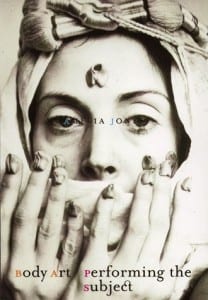 (Image Available from: http://ecx.images-amazon.com/images/I/51CN7QKAXQL.jpg)
(Image Available from: http://ecx.images-amazon.com/images/I/51CN7QKAXQL.jpg)
La Pocha Nostra’s Influence
This week my group and I have been looking more deeply into La Pocha Nostra and we have drawn a great deal of inspiration from their work and theories. We have decided on creating personas and are interested in the idea of a human zoo style setting. Every member of our group has felt like an outcast or outsider at some point in their life, and this is a recurring theme in much of La Pocha Nostra’s work. La Pocha Nostra are a trans-disciplinary arts organization founded by Guillermo Gómez-Peña. They focus on breaking down national border boundaries and working with artists from all races, sexualities, genders and ages to create groups of ‘rebel artists’.
Their book ‘Exercises for Rebel Artists: Radical performance pedagogy’ is filled with numerous exercises to create and explore personas. “We become the spectacle of our identities using our highly decorated bodies. In this sense we are always, physically, culturally and technologically hybrid beings.” (The Pocha Nostra Manifesto, 2012) This has had profound impact on the creation of our piece; we used many of La Pocha Nostra’s exercises to begin building our personas, based on our individual identities. For example we used a personal questioning process exercise. The space was used as a sliding scale, from 1 (strongly disagree) to 10 (strongly agree). We then asked questions such as “How culturally diverse are you?” or “How sexually liberated do you feel?” and the group members stood in the position in the room that reflected their response to the question. This helped to identify aspects of our personas and points of similarity or difference in the group.
Another exercise from La Pocha Nostra’s book we used was imitation. We picked another artist in the group and embodied their persona; this helped us to view our own personas from other people’s perspectives. This helped us focus on the areas of our personas that we need to emphasise.
La Pocha Nostra have helped us to push ourselves as artists and to discover ourselves as individuals. We have been provoked into, passion, anger and from some, rebellion. This has been a very motivating and identity shaping part of my group’s process.
(Image available from: http://images.tandf.co.uk/common/jackets/amazon/978041554/9780415549233.jpg)
Brett Bailey and The Human Zoo.
Brett Bailey’s performative art piece called Exhibit B was a ‘human zoo’ which aimed to capture the treatment of Native Africans, however it caused controversy with some believing it was racist due to his white South African heritage.
Like Brett Bailey, we want to create enclosures for our personas from our own belongings, particularly items that reflect or influence our identities. Like the performers in Exhibit B we want to be observed in an environment that reflects our lives and identities.
(Image available from: http://www.agendamagazine.be/sites/default/files/1327_kfda_brett_bailey.jpg)
“Bailey does not consider any of the pieces complete without the addition of the spectator”(O’mahony. 2014); we want to create a more personal and intimate element in our piece, so the information needed to help the audience understand and ‘define’ us has to be both given and received voluntarily. We have decided to do this in the form of secret letters, which will be handed out to observers during the performance.
We want to challenge our audience’s judgements by exposing them to the process of transformation from a bare and average human body, to the external decoration of our body’s identities. The piece is designed to be appreciated in an artistic and aesthetic sense and to provoke thoughts about the human being that exists beneath the visual display of identity.
Finalised Performance
Blurb – Fetishised, Masculine, Meditative, Rebellious, Queer. Five vessels used to explore their own identities and those imposed upon them. We invite you to come and observe this silent piece of performative art.
The Meditative Body
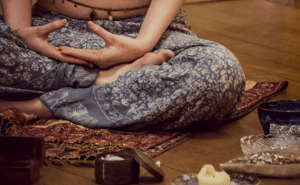 My persona reflected my identity as someone who was raised amongst new age travellers, I embrace mindfulness and acceptance. I have been instilled with a deep appreciation for nature from a young age and desire nothing more than to create a life that reflects these values. This is what I aimed to reflect in the performance, although I also wanted to present this in an exaggerated way, that also hinted towards the stereotype people from backgrounds like mine are often attached to.
My persona reflected my identity as someone who was raised amongst new age travellers, I embrace mindfulness and acceptance. I have been instilled with a deep appreciation for nature from a young age and desire nothing more than to create a life that reflects these values. This is what I aimed to reflect in the performance, although I also wanted to present this in an exaggerated way, that also hinted towards the stereotype people from backgrounds like mine are often attached to.
My Appearance:
- Black underwear
- Harem pants
- Cut off vest
- Gemstone waist chain
- Crystal necklace
- Assorted rings
- Moonstone ‘third eye’ headdress
My Enclosure:
- Incense chest
- Incense burner
- Candles
- Bowls containing; Chai seeds, Lavender and Chamomile
- Assorted crystals
- Essential oils
- Kahlil Gibran’s The Prophet
Spectators were encouraged to come closer to our enclosed space, in order to recieve a ‘letter of confession’ revealing details about the performers’ individual personas:
- My body is my mind’s peaceful shelter in a soulless society.
- “Your ears thirst for the sound of your heart’s knowledge. You would know in words that which you have always known in thought.” – Kahlil Gibran
- My mother cut off her dreadlocks because other mothers at the school wouldn’t have me round for tea.
- I pay my taxes
Performance Review
Our performance was incredibly relieving and satisfying, the performers we were all incredibly focused, we received more spectators than we had originally anticipated. Our performance lasted just over an hour as we repeated the rituals twice. All performers began the piece in plain black underwear in the neutral position, every 3 minutes performers would adorn themselves with an item of clothing or an accessory. Once fully dressed, each performer in turn was forcibly manipulated into a tableau which reflected their particular persona (Fetishised, Masculine, Meditative, Queer, Rebellious), after which we knelt and built our enclosure around ourselves. It was important that each item was treated with the utmost care and respect, as they were deemed precious enough to represent our identities. Each performer then embodied their persona and began living in the space as truthfully as possible, during this period performers handed out their letters of confession. After a sustained period of time we slowly and delicately began to pack our enclosure back into the containers, before performing an exaggerated version of our earlier tableaux. To conclude the rituals, we then undress, stripping ourselves of our decorative attire and returning to the blank canvas that stood before the spectators at the start the performance.
I believe the performance fulfilled our aims of presenting every human body as a work of art and making the connection between art and identity. We hope that people came to appreciate our identities as worthy of memory and the title of ‘Art’. However, if I was to continue with this performance, I would take more time to design and create each body’s enclosure, creating the kind of beauty and truth a performance of this style deserves. I also feel that it was unfortunate that the piece was only received under an assessment setting, as the audience seemed to feel a need to sit quietly and observe, rather than explore and engage with the performance. This meant that the small but important details we had created (such as the letters of confession) went unnoticed by many and so, I imagine, some depth and understanding may have been lacking for those who did not actively seek out the interesting details. Although there were perhaps some changes that could have been made, this has been the most deeply personal and self-reflective piece of performance art, or indeed piece of theatre that I have created to date. I have learnt a great deal from this module, but above all else I prize the opportunity to explore my own identity and the experiences that have shaped it, to share this with my fellow performers and to have the privilege of witnessing my fellow performers come to an understanding of their identities alongside me.
Bibliography:
- Jones, A. (1998) Body Art: Performing the Subject. Minnesota: University of Minnesota Press
- James, R. R. (1974) Winston S. Churchill: His Complete Speeches, 1897–1963. vol. 6 London. Chelsea House Publishers.
- Wrights and Sites (2001) Out of Place: The Politics of Site-Specific Performance in Contested Space [online] Available at: http://www.mis-guide.com/ws/documents/politics.html [Accessed 8th April 2015]
- Pearson, M. (2010) Site-Specific Performance. London: Palgrave Macmillan.
- Pearson, M. Shanks, M. (2001) Theatre/Archaeology. London: Routledge.
- Gleave, J. (2011) The Reciprocal Process of the Site and the Subject in Devising Site-Specific Performance. University of Birmingham
- La Pocha Nostra. The Pocha Nostra Manifesto [online article] Available from: http://www.pochanostra.com/ [Accessed 29th March 2015]
- O’Mahony, J. Edinburgh’s most controversial show: Exhibit B, a human zoo. The Guardian. [online] Available at: http://www.theguardian.com/stage/2014/aug/11/-sp-exhibit-b-human-zoo-edinburgh-festivals-most-controversial [Accessed 16th April 2015]
- Show of Force LLC and Mudpuppy Films Inc. (2012) Marina – A Documentary Film about Marina Abramović: About Marina Abramovic. [Online] New York: Show of Force LLC and Mudpuppy Films Inc. Available from http://marinafilm.com/about-marina-abramovic [Accessed 11 February 2015]
- Weide, S. 2011. The value of museums: Stronghold for museum institutions in times of financial instability. NEMO News [online] January. Available at: http://www.ne-mo.org/fileadmin/Dateien/public/NEMONews/nemoNews_1-11www.pdf [Accessed 10th February 2015]
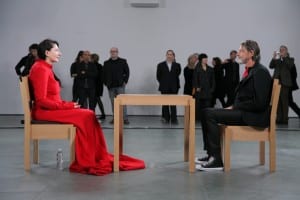
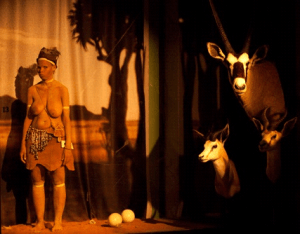
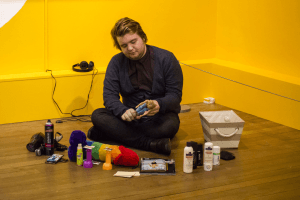
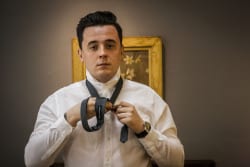
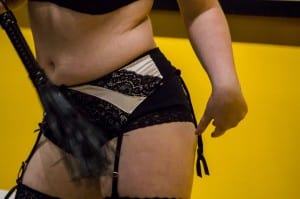
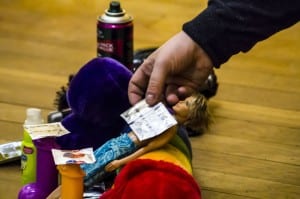
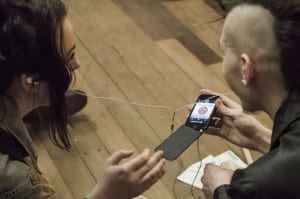
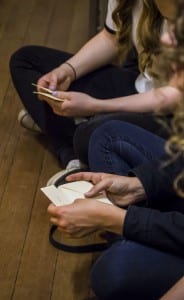
Recent Comments